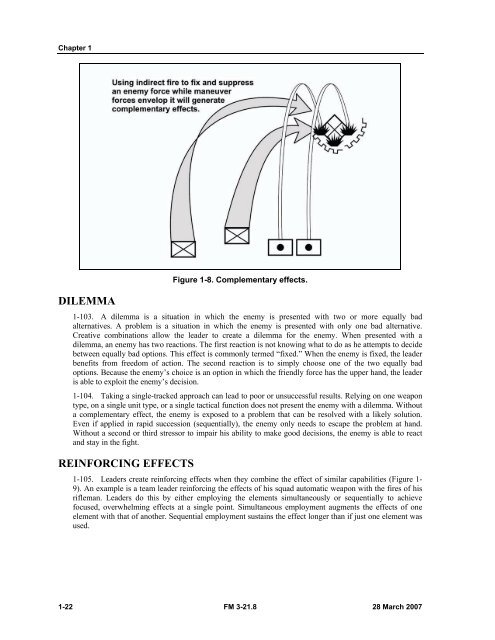Infantry Rifle Platoon and Squad - Sakai
Infantry Rifle Platoon and Squad - Sakai
Infantry Rifle Platoon and Squad - Sakai
You also want an ePaper? Increase the reach of your titles
YUMPU automatically turns print PDFs into web optimized ePapers that Google loves.
Chapter 1<br />
DILEMMA<br />
Figure 1-8. Complementary effects.<br />
1-103. A dilemma is a situation in which the enemy is presented with two or more equally bad<br />
alternatives. A problem is a situation in which the enemy is presented with only one bad alternative.<br />
Creative combinations allow the leader to create a dilemma for the enemy. When presented with a<br />
dilemma, an enemy has two reactions. The first reaction is not knowing what to do as he attempts to decide<br />
between equally bad options. This effect is commonly termed “fixed.” When the enemy is fixed, the leader<br />
benefits from freedom of action. The second reaction is to simply choose one of the two equally bad<br />
options. Because the enemy’s choice is an option in which the friendly force has the upper h<strong>and</strong>, the leader<br />
is able to exploit the enemy’s decision.<br />
1-104. Taking a single-tracked approach can lead to poor or unsuccessful results. Relying on one weapon<br />
type, on a single unit type, or a single tactical function does not present the enemy with a dilemma. Without<br />
a complementary effect, the enemy is exposed to a problem that can be resolved with a likely solution.<br />
Even if applied in rapid succession (sequentially), the enemy only needs to escape the problem at h<strong>and</strong>.<br />
Without a second or third stressor to impair his ability to make good decisions, the enemy is able to react<br />
<strong>and</strong> stay in the fight.<br />
REINFORCING EFFECTS<br />
1-105. Leaders create reinforcing effects when they combine the effect of similar capabilities (Figure 1<br />
9). An example is a team leader reinforcing the effects of his squad automatic weapon with the fires of his<br />
rifleman. Leaders do this by either employing the elements simultaneously or sequentially to achieve<br />
focused, overwhelming effects at a single point. Simultaneous employment augments the effects of one<br />
element with that of another. Sequential employment sustains the effect longer than if just one element was<br />
used.<br />
1-22 FM 3-21.8 28 March 2007

















